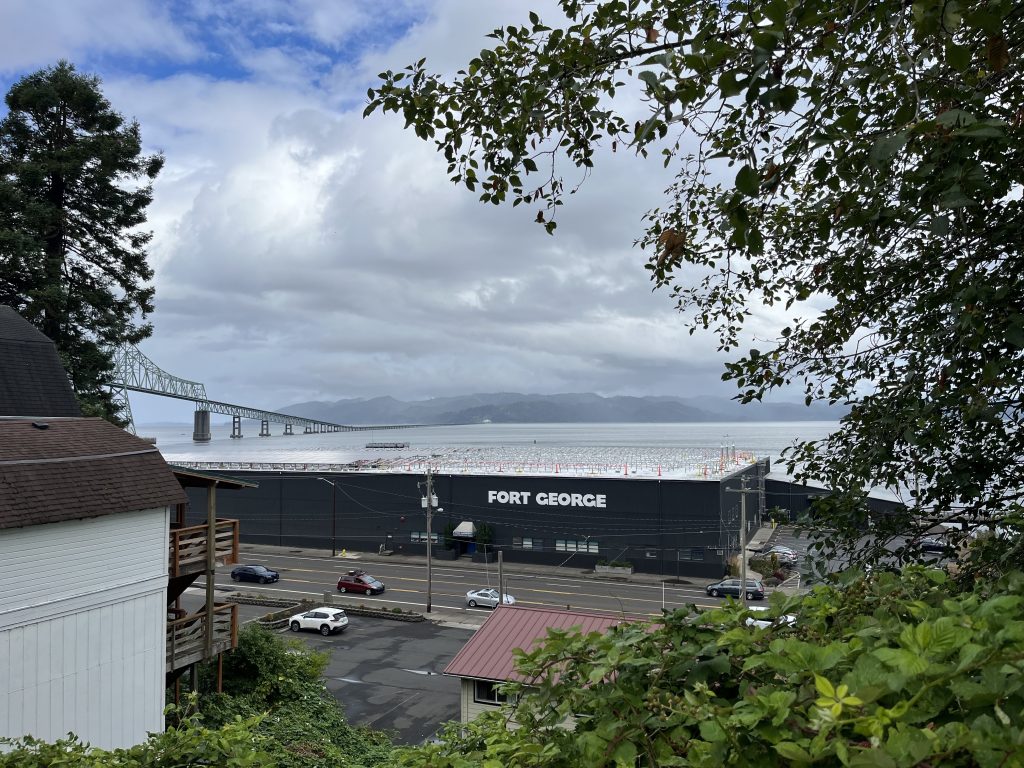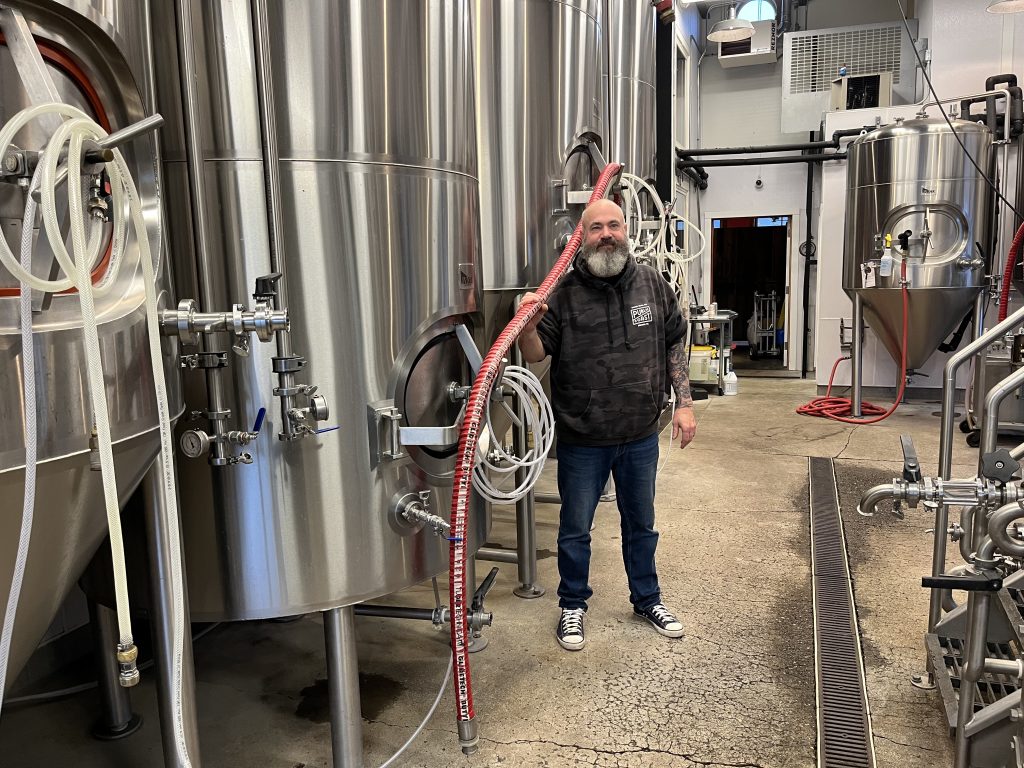By William Dean
The roots of Chris Nemlowill’s passion for clean, renewable energy can be traced to elementary school in Astoria.
In his sixth-grade science class, he built a miniature solar-powered car. It was pretty cool. He’s been fascinated by the planet-friendly energy source ever since.
Flash forward to 2019, when Nemlowill’s Fort George Brewery acquired a sprawling warehouse flanking the Columbia River as the forever home of its main brewing facility.
Even as the towering brew tanks were being installed, there was zero doubt that the flat roof – bigger than a football field – would one day be covered with solar panels.
A couple of weeks ago, Nemlowill stood on that very roof, surveying the impressive array with pride. The sage green Astoria-Megler Bridge loomed to the west, the wide, blue river sparkled immediately to the north.
“This is a perfect, perfect spot for a largescale solar project,” the owner and co-founder of Fort George said. “There are no trees above it, no other structures taller than it in the area, so it just has direct sunlight on the entire top.”
“We had to go for it. It just totally made sense.”
The project, nearing completion with a tentative turn-on date in early October, represents the state of the art, with the entire 67,000-square-foot roof replaced by a reflective white membrane that allows sleek “bifacial” panels to absorb the sun’s rays from above and below.
A staggering 1,167 panels will generate 560 kilowatts of electricity – enough to power the equivalent of 220 homes and erase 70 to 80 percent of the brewery’s power bill.
The array and its installation will cost an estimated $2.4 million, with Fort George paying the bill with $1.1 million in grants and a loan.
It’s the biggest solar project on the North Coast.
It’s also the biggest array involving a single, privately owned building in Oregon, according to Nemlowill, who adds “which is cool.”
“We have to be good stewards of our environment,” he says. “It’s very important.”
***
When Nemlowill and Jack Harris opened Fort George in what had been a dilapidated building on Duane Street, the concept of community was baked in.
It’s why they called the brewpub a “public house” and why they sought to set a positive, forward-looking example from the start.
That was 17 years ago, but the mission continues.
The brewery has given back more than $1 million to nonprofits to date, with much of the money going to environmental and conservation causes. Fort George has also joined the 1% for the Planet initiative, which requires businesses to donate at least 1 percent of annual sales to certified environmental organizations.
Nemlowill, who drives an all-electric Ford Lightning pickup, proudly notes that the brewery’s sales vehicles are all plug-in hybrids, and that there are EV charging stations by the downtown brewpub and waterfront facility.
He’s toured alternative energy projects in Europe and returned with a yearning to innovate, often recapping in passionate terms what he witnessed in Denmark, Germany and elsewhere. Why aren’t those efforts being duplicated more often in America, he wonders.
Solar and wind power. Electric vehicles. Nemlowill sees that as “the future” – spurred by tax benefits and government grants – but only if more businesses and homeowners step up to the plate.
“For us as a society to be around here for the next couple hundred years, we’re going to have to take some big swings – take some chances and risks,” he says. “You’ve got to try things. Try to do better all the time.”

Astoria Mayor Sean Fitzpatrick applauds Fort George’s “big swing” with its rooftop array.
Before the panels began being installed, the city with a population of 10,000 could only cite non-residential solar roof projects at the Astoria Co-op and a couple of buildings at Clatsop Community College.
Fitzpatrick hopes the brewery is setting an example for others to follow.
“I’m very proud of it,” the mayor said of Nemlowill’s project. “I’m amazed at what he’s been able to accomplish.”
Nemlowill refuses to take all the credit, praising the steadfast support of employees and a long list of managers for helping shepherd the project through years of planning, grant requests and lobbying of politicians.
“It feels really good,” he says. “It’s the right thing for our community and our business. Our staff is extremely excited about it.”
***
If all goes according to plan, Fort George will recoup its solar investment within five years. During peak summer energy demand, there will be less strain on the grid.
While solar only accounted for less than 2 percent of Oregon’s electricity generation in 2020, that sector is expected to grow rapidly as power rates climb.
The million-dollar federal grant for Fort George’s project came from the U.S. Department of Agriculture’s Rural Energy for America Program (REAP), using funds allocated under the Inflation Reduction Act.
REAP’s Oregon director, Margi Hoffmann, said the agency is doing more than offering grants. It’s also “lowering barriers and opening doors” by providing rural businesses with grant-writing and other technical support.
While a handful of other Oregon breweries and a number of wineries have gone solar, the sheer size of the Fort George project has eclipsed them. That’s created a friendly rivalry of sorts.
Crosby Hop Farm in the Willamette Valley heard about the Astoria array and now wants to expand its solar capacity, according to Justin Wilbur of Advanced Energy Systems, the Eugene-based company building Fort George’s system.
“It definitely has been a chain reaction,” Wilbur says. “These things trigger people to look at alternative energy.”
One hurdle is the nagging perception that Oregon is too cloudy and rainy for solar. Wilbur points out that the state is at the same latitude as Germany, which now generates nearly two-thirds of its electricity from solar and other renewable sources.

Nemlowill hopes his project becomes a catalyst.
“I think it’s going to be super-inspiring to people and make them curious,” he says. “Hey, should I be putting solar on my house? Should I be putting solar on my business?
“We have to do something. We cannot continue down a path of not trying stuff out, not trying to be sustainable. Our planet’s getting warmer. We’ve got to do something about it.”
This article originally appeared in the September 2024 issue of HIPFiSH Monthly.




